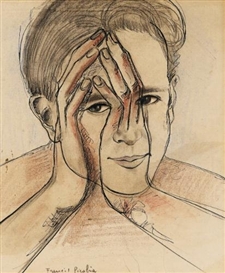Francis Picabia’s Elusive Transparencies
The captivating dreamlike paintings are unique in their enigmatic beauty, and while they draw elements from throughout art history, their meaning remains a mystery
Bianca Spaggiari / MutualArt
Nov 13, 2020
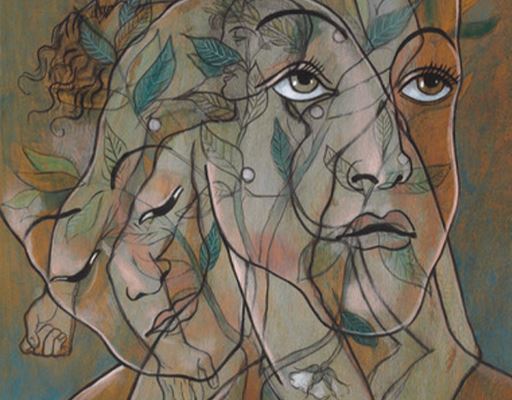
The captivating dreamlike paintings are unique in their enigmatic beauty, and while they draw elements from throughout art history, their meaning remains a mystery.
Francis Picabia, Medea, ink, pencil, watercolor and gouache on cardboard, ca. 1929, 105,9 x 76 cm, © Courtesy of Christie’s
Following his break with the Parisian avant-garde in 1924, Francis Picabia (1897-1953) moved to the French Riviera in southern France, soon thereafter beginning to work on his radical Transparencies paintings. The painter occupied himself with the series from circa 1927 to 1933, and the result was a body of work that draws elements from and refers to a wealth of sources, weaving together biblical and mythological subjects, disparate forms in multiple dimensions, cool and warm nuances, glazed and opaque strata, and flawless as well as imperfect geometries and sensuous lines.
The Transparencies’ series lacks a set narrative or explicable allegory – aside from their deceptive clarity of reference – which is paralleled by the paintings’ lack of formal interpretation in spite of their classical beauty. This made Picabia’s Transparencies one of his most inscrutable and misunderstood bodies of work. Nevertheless, the complexly interlaced subjects and blended faces are both enthralling to the mind and charming to the eyes and soul. Although the series lacks overall meaning, it is clearly rooted in Picabia’s artistic development and the movements he had previously affiliated with, and it is the culmination of his fifty-years long career. After achieving prominence as a Cubist painter he became a fervent Dadaist, during which time he produced his celebrated mechanical paintings and portraits. He later moved away from the aesthetic of shock, renouncing the Dada philosophy, and retuned to figurative painting after years of experimenting with abstractions.
The creation years of the Transparencies can be split into two stages: an earlier phase starting from 1927, the most paintings of which years were exhibited at the Galerie Théophile Briant in Paris, and a later phase that began in 1929 and lasted up to around 1933.
Francis Picabia, Hera, oil, gouache, charcoal and pencil on board, 1929, 103.4 x 74.9 cm, © Courtesy of Christie’s
Executed in 1929, Hera is visually attractive and captivating. The artwork is primarily based on cold and ethereal hues and displays three beautiful feminine faces emerging from a watery blossoming background. Behind the three heads the back of a nude figure can be identified, a potential metaphor to one's emotional status, often deceived by an outstandingly beautiful face. Others identify an erotic position instead, corroborated by the visible hands embracing the body. The narrative Picabia reveals seems to free itself from any moral restriction, and, moreover, is a deliberate expression of his innermost desires. The work evidently draws from classical imagery, a marked dedication to the figure, as opposed to some of his previous paintings. According to many studies, the motifs used by Picabia stem from the Classical, the Renaissance, and from Catalan Romanesque. Noteworthy, however, is the distinct presence of the natural world. While Botticelli and Piero Della Francesca are clear sources of inspiration behind this artwork, there is also the use of a vibrant blend of gouache, pastel, charcoal, and pencil, and Picabia delineated curly yet aesthetic lines to frame the figures, as well as a gracefully executed delicate floral pattern. These were likely inspired by Paul Girod's natural descriptions, used frequently by Picabia at the time. Despite its complexity, Hera is an ethereal composition, evoking transcendence and beauty, instilling a sense of calm and dreaminess in the viewer.
Francis Picabia, Ligustri, oil, gouache and brush and black ink over pencil on panel, ca. 1929, 151.5 x 96.2 cm, © Courtesy of Christie’s
Besides Hera, several of the Transparencies recall mythological themes. With time, the series slowly increased in intricacy, with a growing variety of themes and connotations. Common denominators are interlaced lines that gradually unfold to the attentive observer. Ligustri was painted in 1929 and influenced by Picabia's cinematographic experience from his 1924 short film Entr’Acte, which he wrote with Rene Clair, who also directed it, investigating the third dimension. The hunt for a multi-dimensional painting was asserted by Gertrude Stein, a dear friend to Picabia, who praised his pursuit of something that went beyond the flat surface. Ligustri was the result of an epiphany in a moment spent in a Cafè in Marseille, when, while seated in front of a glass window, Picabia witnessed the overlapping image of its interior ambiance with the outside world. Many references to Botticelli are embedded, especially discernible in the delicacy of the feminine portraits, both of which borrow elements from the Bardi Altarpiece and Primavera with their elegant and soft lines – the woman on the right displays an intense but pleasant gaze, as if in a oneiric state – while the blossoms and leaves recall The Birth of Venus. The well-defined bodies, on the other hand, are reminiscent of sculptures from Greco-Roman antiques. Picabia here is forcing figures to create a relationship, alluding to the variety of forms of one's soul. Ligustri was also inspired by Paul Girod’s “L’Atlas de Poche des Papillons de France, Suisse et Belgique,” as Ligustri is a flowering plant and the name of a butterfly that usually lays on it.
Francis Picabia, Atrata, oil and pencil on panel, 149.5 x 95 cm, ca. 1929, © Courtesy of Sotheby’s
Girod inspired Atrata's title too, from the Latin “clothed in black.” Atrata is the emblem of a dreamlike and timeless enigmatic beauty, refined and with a fluid finish. The canvas is imbued with a serene melancholy, expressed by crisp colors, ephemeral forms, and washed pigments. Compared to Ligustri, Atrata was composed with more evident references to classical works. The hands at the bottom are an appropriation of Botticelli’s Portrait of a Man with a Medal of Cosimo the Elder, and the central part of the panel shows the Roman statue of Atlas and his globe, on display at the National Archaeological Museum of Naples. The large hands carrying the globe, however, are again Botticelli's, as with the hands holding the grapes on the lower left. Compared to the hands in Hera, Atrata’s have earthlier colors, almost as if representing a different season.
Left: Sandro Botticelli, Portrait of a Man with a Medal of Cosimo the Elder, © Courtesy of the Uffizi Gallery, Florence
Right: Francis Picabia, Atrata (detail)
Left: Atlas Farnese © Courtesy of National Archeological Museum of Naples, Naples
Right: Francis Picabia, Atrata (detail)
After experimenting with mythological and natural themes, Picabia later began focusing on biblical topics and religious references, replacing the dreamy traits of past Transparencies. Melibée must be ascribed to the second phase of the series. The artwork portrays an unearthly but nature-imbued appropriation of Piero della Francesca’s Madonna and Child with Saints and Angels. The title originates from a Spanish prose work by Fernando de Rojas, titled La Célestine, in which a tragicomic tale tells the love story between Calixte, a young and refined nobleman, and Melibée, the daughter of a merchant. On the canvas, Melibée’s traits gradually separate and unify through secondary motifs to enhance the depth of the painting, pulling the viewer in and plunging him into a suspended status of appreciation of the representation.
Francis Picabia, Melibée, oil on canvas, 1931, 195,5 x 130 cm, ca. © Courtesy of Sotheby’s
In Picabia’s Transparencies, faces, bodies, animals and nature intertwine to form images of singular beauty and completely innovative at the time. These paintings became significantly influential for many painters, especially Sigmar Polke. As Picabia himself said, he wanted artworks where all of his instincts could flow freely, and this series gave him the chance to express his innermost desires and dreams, which elucidates the fact that this body of work is still an enigma to everyone but the artist himself.
For more on auctions, exhibitions, and current trends, visit our Magazine Page


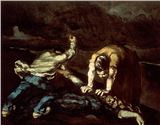
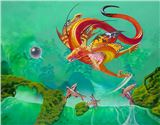

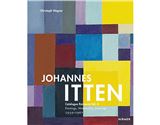
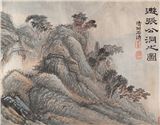
 .Jpeg)
.Jpeg)
.Jpeg)




